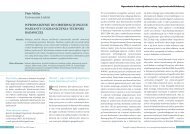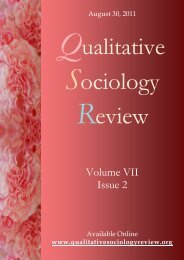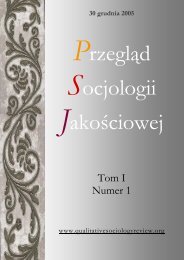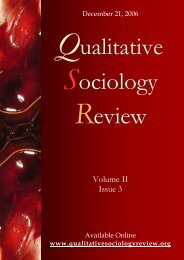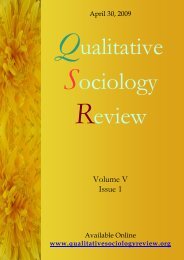Gillies, V. and Edwards, R. - Qualitative Sociology Review
Gillies, V. and Edwards, R. - Qualitative Sociology Review
Gillies, V. and Edwards, R. - Qualitative Sociology Review
You also want an ePaper? Increase the reach of your titles
YUMPU automatically turns print PDFs into web optimized ePapers that Google loves.
generate ensures conformity for the collective good, while also benefiting individuals.<br />
It is a largely a hidden h<strong>and</strong> ”by-product” in providing a social goods that ”are not in<br />
the interest of any individual to produce alone, but …are of benefit to many”<br />
(Coleman, 1988: 392), rather than merely instrumentally driven.<br />
From this perspective, social capital connects families <strong>and</strong> communities <strong>and</strong> is<br />
characterised by a shared set of values <strong>and</strong> expectations. Coleman terms the close<br />
day to day relationships that can develop between parents in a local community<br />
”intergenerational closure” <strong>and</strong> claims the development of such a collective bond<br />
monitors, guides <strong>and</strong> sanctions individual behaviour. For Coleman, there is a crucial<br />
link between social capital <strong>and</strong> children’s educational attainment. In emphasising its<br />
value in the creation of personal skills <strong>and</strong> capabilities or ”human capital”, Coleman<br />
correlates high social capital with a reduced probability of early school drop out<br />
(Coleman, 1988). Many similar studies have since been conducted using large scale<br />
US based data sets to link social capital indicators to academic performance (Dika<br />
<strong>and</strong> Singh, 2002).<br />
According to Coleman, contemporary life is undermining social capital. A<br />
growing diversity of family forms has destabilised the conditions needed to create<br />
<strong>and</strong> sustain social capital. Increases in lone mothers, absent fathers, family mobility<br />
<strong>and</strong> working mothers have all disrupted intergenerational closure <strong>and</strong> have thereby<br />
eroded trusting reciprocal relationships. The absence of fathers through family breakup,<br />
<strong>and</strong> the commitment of mothers to full time employment is seen as amounting to<br />
a structural deficiency, depriving children of necessary developmental time with their<br />
parents. Similarly siblings dilute the time that parents have available for each child<br />
<strong>and</strong> are therefore viewed as depleting social capital resources for individual children.<br />
The welfare state is another threat identified by Coleman, <strong>and</strong> is viewed as<br />
undermining the economic <strong>and</strong> social rationality of parental investment in children,<br />
thereby encouraging a “free-rider” attitude (1991: 6). Consequently, from Coleman’s<br />
point of view, a non-mobile, traditional nuclear family, with a working father, stay at<br />
home mother <strong>and</strong> one or at the most two children represent the ideal structure for<br />
maximising social capital.<br />
In contrast, Bourdieu’s work on social capital is considerably more complex <strong>and</strong><br />
nuanced. For Bourdieu social capital is inextricably linked to a number of other<br />
central resources, or ”capitals”, which determine an individual’s st<strong>and</strong>ing as well as<br />
their likely trajectory. Along with social capital, Bourdieu stresses the significance of<br />
economic capital, cultural capital in the form of institutional status <strong>and</strong> personal<br />
values, <strong>and</strong> symbolic capital representing the construction the other capitals take<br />
when they are legitimated with symbolic power. With social capital deriving from<br />
family <strong>and</strong> other social relationships, its type <strong>and</strong> content is inevitably shaped by the<br />
material, cultural <strong>and</strong> symbolic status of the individual concerned (Bourdieu,<br />
1990,1997). Like Coleman, Bourdieu also sees families as motors of social capital,<br />
but focuses instead on enduring family practices that perpetuate inequity. Family<br />
members with access to symbolic <strong>and</strong> material resources are able to draw on these<br />
capitals in order to cement their advantage, <strong>and</strong> transmit the benefits to their<br />
children. From this perspective, social capital is a resource that can be accumulated,<br />
invested in <strong>and</strong> deployed for instrumental personal advantage.<br />
From Bourdieu’s perspective, there has been no general decline in social<br />
capital. Instead he is concerned with documenting the way individuals are positioned<br />
in social space according to their access to economic, cultural, social <strong>and</strong> symbolic<br />
capital. The amount <strong>and</strong> type of capitals an individual possesses, <strong>and</strong> gains or losses<br />
over time, determines both their position within the social space at any one time, <strong>and</strong><br />
also their overall trajectory. Individuals are born into a designated social space that is<br />
defined by access to capitals, but capitals are also tied to social positions in that<br />
©2006 QSR Volume II Issue 2 www.qualitativesociologyreview.org 44



